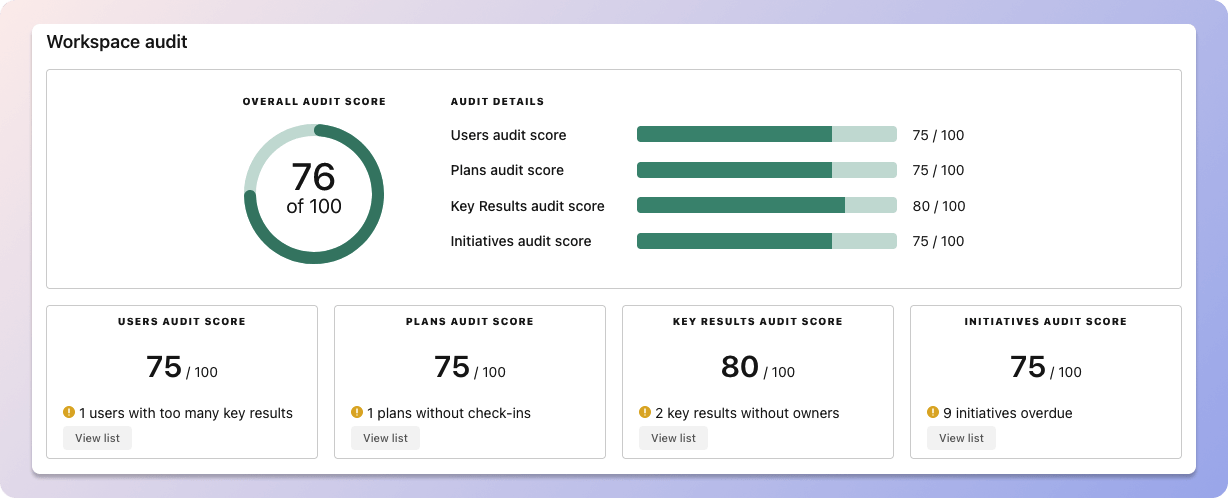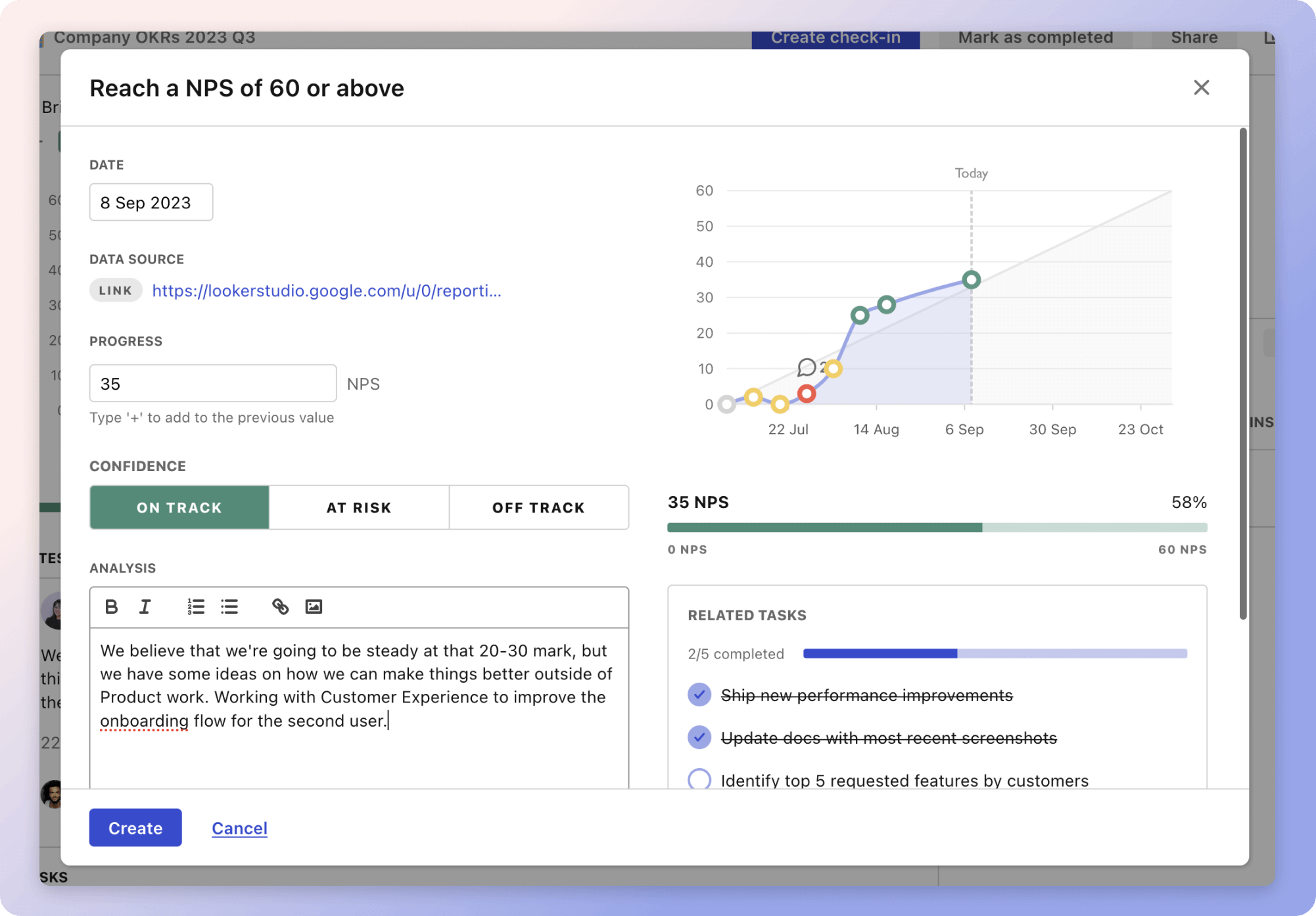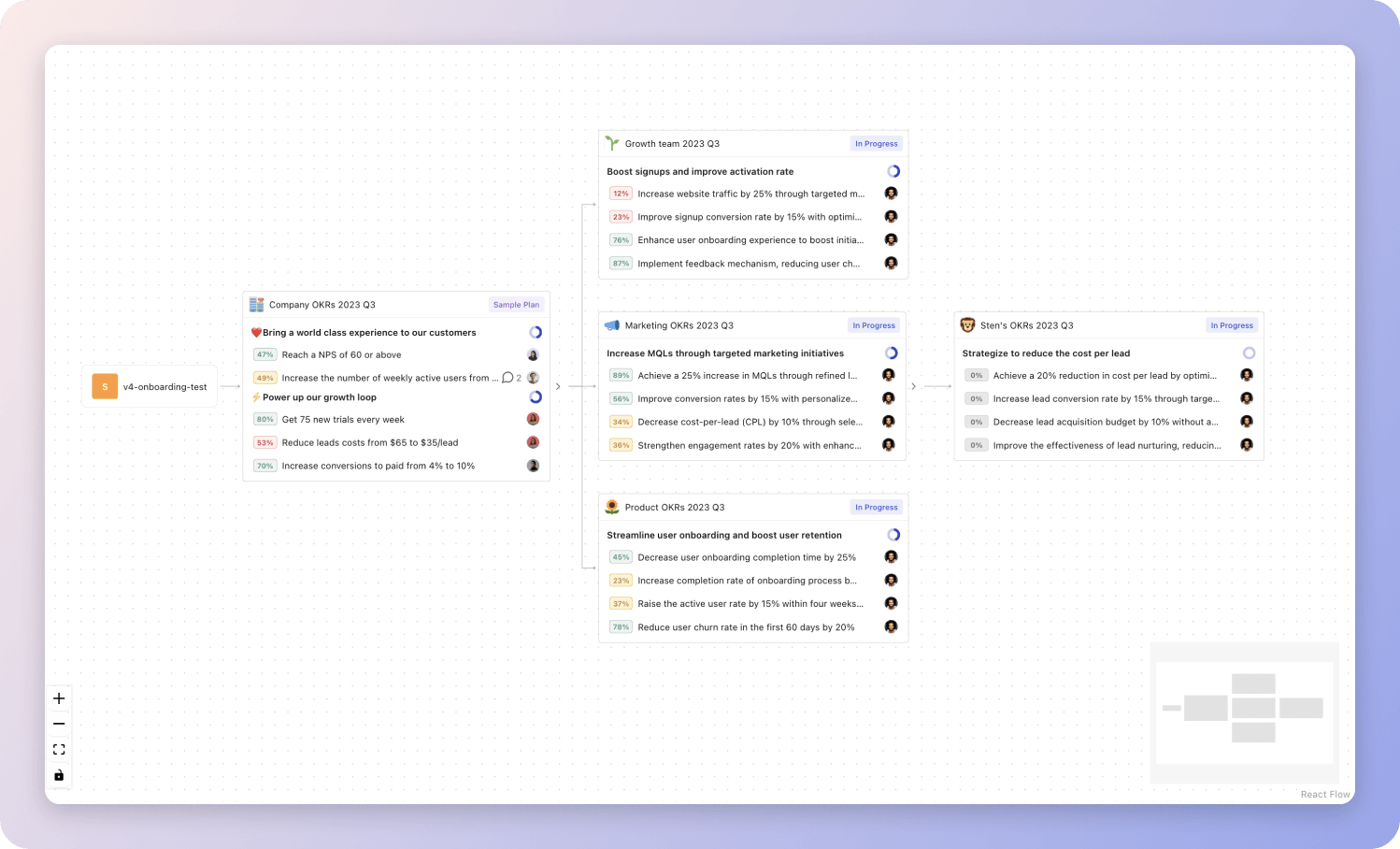3 customisable OKR examples for Return On Investment
What are Return On Investment OKRs?
The Objective and Key Results (OKR) framework is a simple goal-setting methodology that was introduced at Intel by Andy Grove in the 70s. It became popular after John Doerr introduced it to Google in the 90s, and it's now used by teams of all sizes to set and track ambitious goals at scale.
Formulating strong OKRs can be a complex endeavor, particularly for first-timers. Prioritizing outcomes over projects is crucial when developing your plans.
We've tailored a list of OKRs examples for Return On Investment to help you. You can look at any of the templates below to get some inspiration for your own goals.
If you want to learn more about the framework, you can read our OKR guide online.
Building your own Return On Investment OKRs with AI
While we have some examples available, it's likely that you'll have specific scenarios that aren't covered here. You can use our free AI generator below or our more complete goal-setting system to generate your own OKRs.
Feel free to explore our tools:
- Use our free OKR generator
- Use Tability, a complete platform to set and track OKRs and initiatives, including a GPT-4 powered goal generator
Our customisable Return On Investment OKRs examples
You'll find below a list of Objectives and Key Results templates for Return On Investment. We also included strategic projects for each template to make it easier to understand the difference between key results and projects.
Hope you'll find this helpful!
1. OKRs to establish definitive guidelines for all marketing functions
Establish definitive guidelines for all marketing functions
Improve adherence to marketing principles, reducing deviation in marketing activities by 40%
Establish penalties for unnecessary deviations from set standards
Develop a review process ensuring alignment with marketing principles
Implement regular training sessions on fundamental marketing principles
Implement marketing principles across all teams, increasing alignment by 50%
Track and measure alignment progress periodically
Develop a unified strategic marketing plan for company alignment
Conduct workshops on essential marketing principles for all teams
Formulate 5 universal marketing principles that enhance ROI by 30%
Develop and detail five universal marketing principles
Research universal marketing principles in successful campaigns
Identify current successful marketing strategies that increase ROI
2. OKRs to improve financial operations for increased efficiency and effectiveness
Improve financial operations for increased efficiency and effectiveness
Implement a new budgeting strategy, ensuring 95% adherence to it
Conduct training on new budget adherence
Develop comprehensive, realistic budget strategy
Regularly monitor and assess budget compliance
Reduce operational costs by 10% through optimizing resource allocation
Implement optimization strategies for resource allocation
Evaluate success metrics post-implementation
Analyze current resource distribution for inefficiencies
Increase return on investment by 15% via strategic financial decisions
Implement cost-cutting measures across all departments
Evaluate and identify profitable long-term investment opportunities
Restructure high-cost debt to reduce expenditure
3. OKRs to efficiently manage and optimize our team's budget performance
Efficiently manage and optimize our team's budget performance
Deliver 100% accurate budget reports every fortnight for effective tracking
Organize all relevant financial data every two weeks
Develop accurate budget reports from collected data
Submit the completed reports for tracking promptly
Reduce unnecessary expenditures by 15% for improved budget efficiency
Negotiate with vendors for reduced cost of services
Implement monitoring system for discretionary spending
Identify and eliminate non-essential business expenses
Increase budget ROI by 10% through strategic allocation of resources
Analyze current spending to identify inefficiencies or wasted resources
Implement a strategic plan prioritizing high ROI initiatives
Regularly review and adjust resource allocation as needed
Return On Investment OKR best practices to boost success
Generally speaking, your objectives should be ambitious yet achievable, and your key results should be measurable and time-bound (using the SMART framework can be helpful). It is also recommended to list strategic initiatives under your key results, as it'll help you avoid the common mistake of listing projects in your KRs.
Here are a couple of best practices extracted from our OKR implementation guide 👇
Tip #1: Limit the number of key results
Having too many OKRs is the #1 mistake that teams make when adopting the framework. The problem with tracking too many competing goals is that it will be hard for your team to know what really matters.
We recommend having 3-4 objectives, and 3-4 key results per objective. A platform like Tability can run audits on your data to help you identify the plans that have too many goals.
 Tability's audit dashboard will highlight opportunities to improve OKRs
Tability's audit dashboard will highlight opportunities to improve OKRsTip #2: Commit to weekly OKR check-ins
Setting good goals can be challenging, but without regular check-ins, your team will struggle to make progress. We recommend that you track your OKRs weekly to get the full benefits from the framework.
Being able to see trends for your key results will also keep yourself honest.
 Tability's check-ins will save you hours and increase transparency
Tability's check-ins will save you hours and increase transparencyTip #3: No more than 2 yellow statuses in a row
Yes, this is another tip for goal-tracking instead of goal-setting (but you'll get plenty of OKR examples above). But, once you have your goals defined, it will be your ability to keep the right sense of urgency that will make the difference.
As a rule of thumb, it's best to avoid having more than 2 yellow/at risk statuses in a row.
Make a call on the 3rd update. You should be either back on track, or off track. This sounds harsh but it's the best way to signal risks early enough to fix things.
How to turn your Return On Investment OKRs in a strategy map
Quarterly OKRs should have weekly updates to get all the benefits from the framework. Reviewing progress periodically has several advantages:
- It brings the goals back to the top of the mind
- It will highlight poorly set OKRs
- It will surface execution risks
- It improves transparency and accountability
We recommend using a spreadsheet for your first OKRs cycle. You'll need to get familiar with the scoring and tracking first. Then, you can scale your OKRs process by using a proper OKR-tracking tool for it.
 Tability's Strategy Map makes it easy to see all your org's OKRs
Tability's Strategy Map makes it easy to see all your org's OKRsIf you're not yet set on a tool, you can check out the 5 best OKR tracking templates guide to find the best way to monitor progress during the quarter.
More Return On Investment OKR templates
We have more templates to help you draft your team goals and OKRs.
OKRs to streamline the process of generating quarterly reports
OKRs to incrementar la audiencia del newsletter al doble
OKRs to enhance the pipeline's quality and quantity to boost revenue
OKRs to enhance life quality and mental health
OKRs to successfully migrate on-prem applications to cloud setup
OKRs to enhance pre-audit inspection for REV Vistex controls efficiency
OKRs resources
Here are a list of resources to help you adopt the Objectives and Key Results framework.
- To learn: What is the meaning of OKRs
- Blog posts: ODT Blog
- Success metrics: KPIs examples
Create more examples in our app
You can use Tability to create OKRs with AI – and keep yourself accountable 👀
Tability is a unique goal-tracking platform built to save hours at work and help teams stay on top of their goals.
 1 Create your workspace
1 Create your workspace 2 Build plans in seconds with AI
2 Build plans in seconds with AI 3Track your progress
3Track your progress